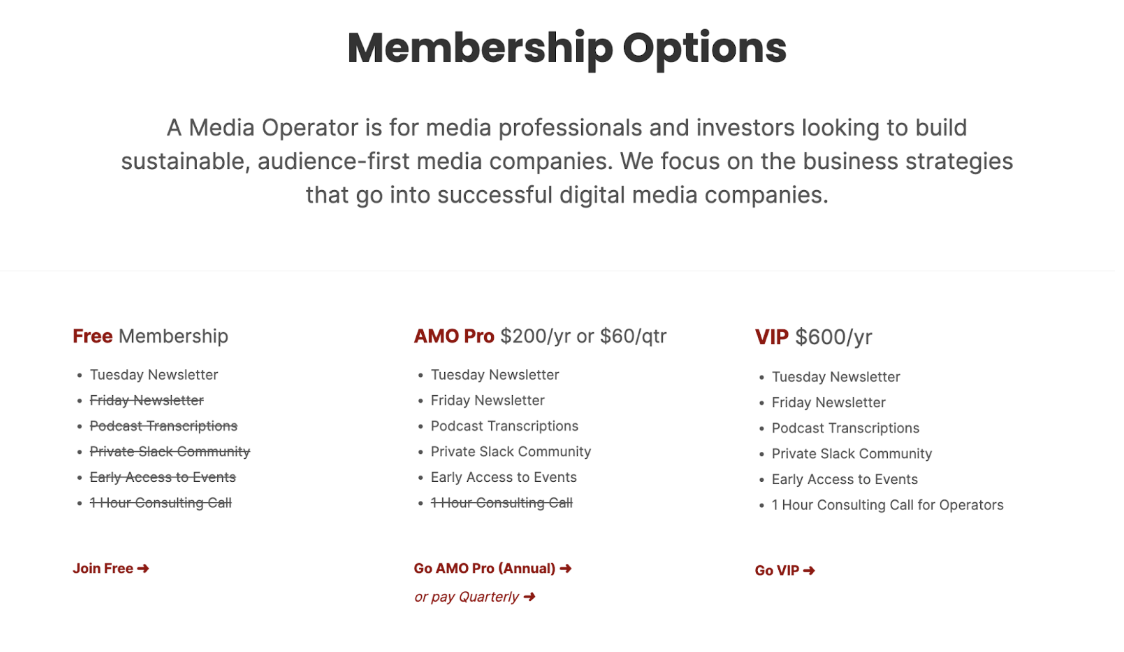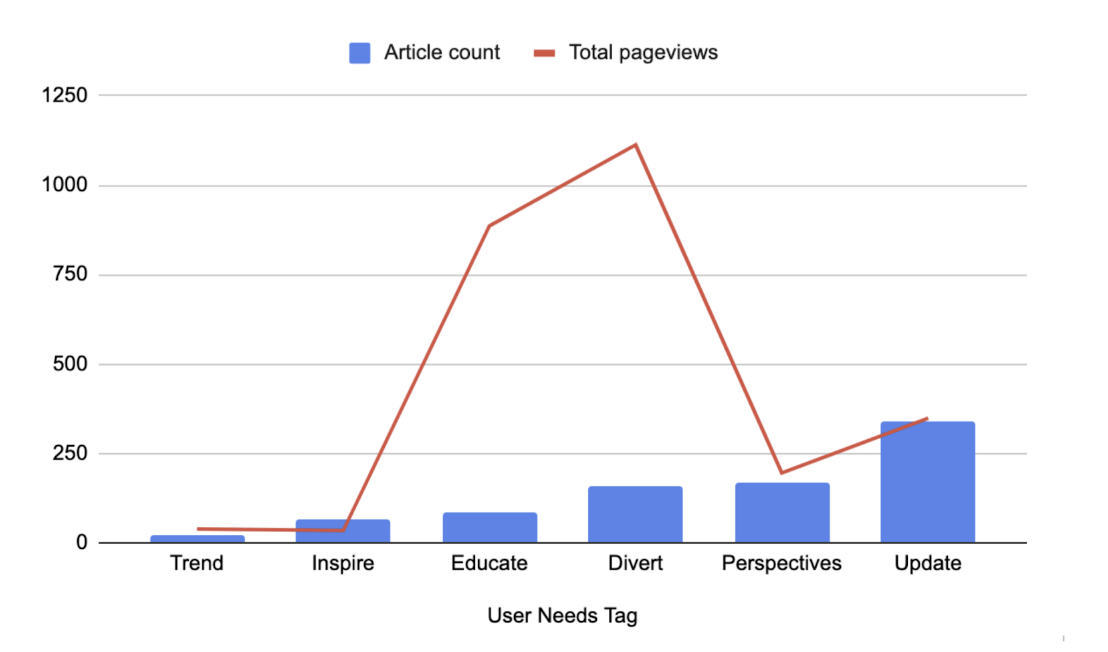How to harness user needs to grow, engage and monetize your audience
Last updated: April 23, 2024

Your audience is moving from Facebook and Twitter to Instagram, TikTok, Discord, Reddit. You’ve got to keep up, but you’ve still got only so many hours in the day. Without a set strategy, you risk losing the forest for the frees — completing a series of tasks to “cover” each channel rather than thoughtfully, deliberately building community through content.
So how can you keep pleaasing your audience without succumbing to aimless busywork? Tie your content and engagement strategy to user needs. This ensures that you’re prioritizing only the initiatives that’ll create community and value.
And it works, according to research from the BBC, which originated the user needs model in 2016. Dmitry Shishkin, then a digital editor at the BBC World Service, proposed six key reasons why BBC users came to their site, then crafted content addressing each of these needs. This includes:
Stay ahead and read our Q3 2023 email engagement report to uncover trends & best practices for success:
- Update me: share the basic facts of a new story
- Give me perspective: analyze the story within a broader social, political, industry context. Or in other words, tell readers what the story means for them and the world.
- Educate me: tell the reader something more about a person or subject in the story
- Divert me: show the reader something less serious related to the story
- Inspire me: feature someone related to the story who’s overcome obstacles or
- Keep me on trend: tell the reader what other people or institutions are saying about the event
Five years after adopting user needs, the BBC had tripled its audience size and increased average metrics per story for each of these user needs, all while producing 60% fewer articles. That’s a formula we can get behind.
Since then, consumer news organizations such as The Atlantic, The Conversation and The Financial Times have adopted the model to great success. But we haven’t seen it as frequently in the business and niche spaces.
We think that’s a missed opportunity. In the post-traffic, the publishers with the best connection with their audiences will rise to the top. The user needs model gives your team a systematic, objective way to put your audience first — and helps you achieve better results with less effort and budget.
How to harness user needs to engage, activate and monetize your audience
User needs is a great strategic framework for understanding and serving your audience. But strategy is useless if it’s not supported by execution.
For instance, if your audience data’s siloed or incomplete, you won’t be able to identify your user needs accurately, much less address them with your content. If your content’s not meeting the right user needs, or you’re not hitting the right ratio, you’ll miss opportunities to engage and connect with your audience. And if you’re not planning your subscription and products around user needs, you won’t be able to turn that new engagement into new business.
So in this post, we’re teaching you how to leverage user needs to grow, engage and monetize your audience. More on that next:
Unify your audience data
You can’t identify your audience’s needs if you can’t see how they’re engaging with you across every channel. And if your audience data’s siloed across a bunch of different tools — your newsletter provider, your website, your social media channels — you won’t have the complete, accurate audience view you need to meet those needs.
So step one: unify your audience data.
One of the best ways to achieve this? Use a customer data platform specifically for media. These tools take in audience data from every channel — email, website and print to ads, events, and print — and consolidate it in one single database. Incoming data automatically flows to the person’s pre-existing profile, and segments update in real time as your audience members meet the underlying criteria.
That means every time Emily clicks an email or visits your website, it’s automatically added to her profile. She’s also added to any relevant segments — no manual transfers and uploads necessary. In one search, your entire team can see how Emily’s engaged with you across every channel — and figure out what she needs.
Multiply that across hundreds or thousands of audience members and it gets a lot easier to pinpoint and address your user needs.
Maximize engagement by matching formats to user needs
Some formats will help you fulfill a particular user need better than others.
Say you’re a B2B publisher in supply chain logistics and you’re covering a high-profile train derailment. If you’re trying to update your audience, you might live tweet the news as it comes in, then embed them onto your website as you go.
But if your primary goal is to educate, you might wait until you’ve got enough information to discuss the derailment in a broader context, project out key implications for the industry, and/or conduct a long-form interview with a subject matter expert about those topics.
On its own, this isn’t entirely ground-breaking. But if you’re feeling the pressure to produce content everywhere all at once, matching formats to user needs will help you prioritize more effectively. You’ll center your content strategy on meeting your audience’s needs first — and maximize engagement across your most important channels as a natural byproduct of that.
Increase revenue by building new products and subscription offers around user needs
So you know how to use user needs to increase site traffic and engagement. But how can you harness that to drive revenue and business?
Tie your products to user needs too. This will help you prioritize your revenue sources more purposefully and invest in the right monetization opportunities. (In other words, the user needs model helps you put your money in the right places.)
Let’s see how this looks for specific user needs. Some examples include:
Educate me: Jacob Donnelly’s A Media Operator (AMO) helps media operators grow, maintain and scale their media business. So it’s not surprising that AMO’s tiered subscriptions provide progressively more educational resources to paid subscribers, with Jacob offering a one-hour consulting call for top subscribers (disclaimer: We periodically sponsor Jacob’s newsletter.)

Connect me: The more you can connect individuals in your community to one another, the more chances they have to learn something new or get inspired. And when that happens, they get more value from you.
That’s why we’re seeing more legacy news organizations investing in both mass-appeal conferences and vertical-specific events (like Fast Company’s Innovation Festival).
Can’t invest in large events? Consider adding a job board and/or Slack communities to your paid subscription package, or host a series of smaller regional dinners for a curated list of professionals. One example: Dine and Deliver, a regional dinner series for a curated list of email professionals co-hosted by Who Sponsors Stuff and Inbox Collective’s Dine and Deliver (disclaimer: We sponsor Dine and Deliver as well.)
Analyze performance by user needs to identify gaps in coverage
You probably already have a sense of what your audience needs from you. But for many publishers, the issue isn’t what needs they should cover, but striking the right balance between those needs. What balance should you strike between education and inspiration? Or hard news updates and entertainment? That’s where things get more difficult — unless you have hard data to back it up.
So once you’ve identified your key user needs, conduct an experiment to see which ones your audience responds to the most. Tag each of your articles with a specific user need, then compare the number of pageviews with the number of articles for each one.
Look for gaps between volume and pageviews for each user need, as these could indicate you’re over- and under-covering that particular area.
For instance, when The Financial Times ran this experiment, they found that for one publisher, “update me” articles drove only 13% of page views despite making up 40% of articles on the site. Meanwhile, ‘divert me’ drove 43% of page views despite making up only 19% of the articles on site.

Source: Financial Times
Analyzing your content performance by user needs helps you put your content creation resources in the right place — and make educated guesses about new, out-of-the-box content ideas.
Run your own test with these tips from the Financial Times:
- “Work with user groups to decide the categories most relevant to them.”
- “Nominate a member of Editorial to tag articles by category for 3 months or until sufficient content is tagged – this can be done retroactively so as not to slow down the publishing process” (Editor’s note: If you’re an Omeda user, you can tag articles, then use our website analytics solution and Tracking Links Clicked report to see how they perform on your website and newsletter, respectively.)
- “Analyze the data: Ideally, consider a full range of metrics in relation to ‘user needs,’ editorial formats and topics. These include but are not limited to time on site, page views, article completion, sharing, social/search impact. If you have a subscription model, you can also look at how categories affect subscription conversion rates. Due to time constraints, our experiments focused mainly on page views and time on site.”
- “Re-evaluate content output by category”
Subscribe to our newsletter
Sign up to get our latest articles sent directly to your inbox.
What you should do now
- Schedule a Demo to see how Omeda can help your team.
- Read more Marketing Technology articles in our blog.
- If you know someone who’d enjoy this article, share it with them via Facebook, Twitter, LinkedIn, or email.